-
Free delivery on purchases of €70 or more to relay points in Europe
-
Enjoy -10% on the Backpacking Food Category with the code: TREKKING10
What Food to Prioritize Before, During, and After a Trail or Ultra-Trail?
It's not always easy to know how to eat optimally before, during, and after a race. If you ask five runners, you'll probably get five different answers. To find out what truly works for your body, you need to dive in and experiment.
The Basics of Nutrition for Running
The quick answer is that if you’re heading out for a run lasting an hour or less, you can probably stick to just drinking water. However, if your run lasts an hour or more, it’s time to start consuming food at a rate of about 200 to 300 calories per hour. For most runners, this means eating and/or drinking 80 to 100 calories every 20 to 30 minutes, primarily in the form of small, carbohydrate-rich snacks like gels, energy bars, and sports drinks.
The exact number of calories depends on several factors, including the length and intensity of your run and your body size. A larger person will likely need more calories per hour than a smaller person. Similarly, someone running a high-intensity race will need more calories per hour than someone on a shorter, easier run.
The quality of the calories you consume is also crucial: carbohydrates are the primary source of energy during a run, while proteins and fats are better suited for before and after your run.
The role of carbohydrates
When you run long distances, your body primarily uses glycogen as its main fuel source. Glycogen is stored in the muscles and liver to provide efficient and easily accessible energy.
Glycogen comes from the consumption of carbohydrates. That’s why you’ve probably heard about athletes carbo-loading the day before an important race. Eating plenty of carbohydrates like pasta, bread, or potatoes helps fill up your glycogen stores and start your race with a full energy tank.
During the race, your body burns through glycogen quite quickly (it can be depleted in a few hours). Therefore, you need to replenish your glycogen stores by taking mid-race snacks like energy bars and gels that contain carbohydrates. If you run out of glycogen, you risk experiencing what athletes call "bonking" or "hitting the wall," meaning you’ll feel really unwell and fatigued.
Clif Bar energy bar - Oatmeal, chocolate chips

The role of proteins and fats
Fat is an essential energy source for your body, but it takes some time to be converted into fuel. This means you can’t eat a high-fat meal right before a race and expect those fats to power you through. To ensure your energy reserves are ready for the long haul, you need to make sure your daily diet includes fats.
Some runners choose to eat a bit of fat during their race, especially during long runs. This can help relieve your taste buds from the monotony of energy gels and help you feel fuller. Adding solid foods like bars, wafers, or peanut butter sandwiches can be a welcome change. But don’t overdo it. Fats take longer to break down than carbohydrates, which can leave you feeling too full and suffering from stomach cramps during your run.
Proteins are not a primary energy source, and therefore, they are usually not a major component of mid-race nutrition plans. However, they should be part of your daily diet and recovery plan after the race.
When you run, your body breaks down muscle tissue. Proteins are ideal for helping your body rebuild tissues and recover after endurance activities. Therefore, after a long run, have a healthy meal containing both carbohydrates and proteins within about 1 to 2 hours. Some athletes are advised to consume protein more quickly (within 30 minutes after the race) to maximize recovery, but the general consensus today is that there’s no rush if you plan to eat within 1 to 2 hours afterward.
Eating small amounts of protein during a long race can be acceptable and may help speed up recovery once the race is over, but limit your intake to about 15g per hour—anything beyond that may leave you feeling too full and uncomfortable.
Develop a nutrition plan
Every runner is different, so it's difficult to dictate a strict eating plan, but there are some reliable guidelines to help you get started. Test foods during training runs to see what works best for you. And never forget: Despite what you're told, if it works for you, keep doing it.
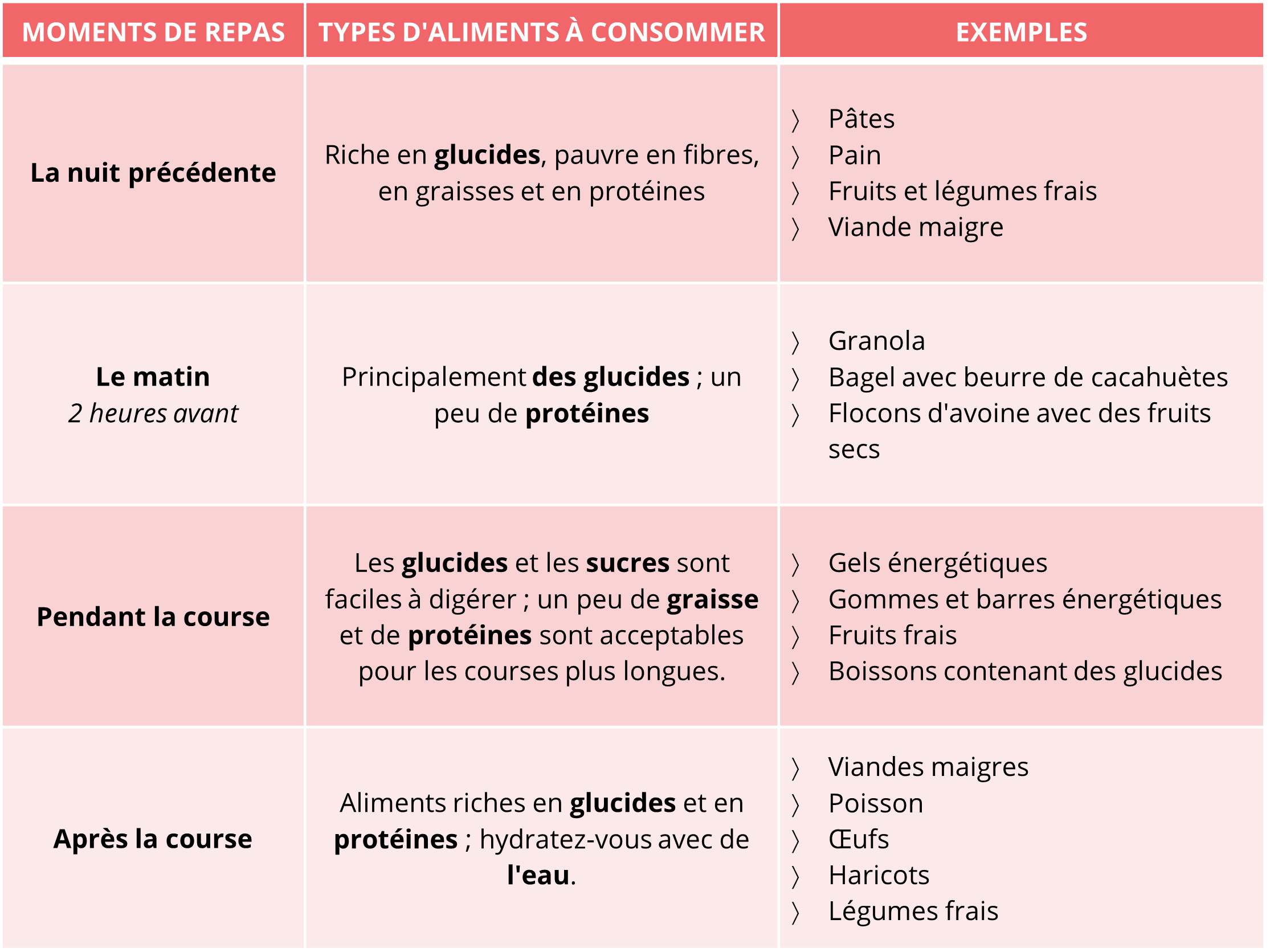
What to eat the daybefore a long run?
The night before a long run (lasting about an hour or more), have a healthy meal that is rich in fats, proteins, and carbohydrates but low in fiber. The fats you consume should be healthy fats from foods like avocados and extra virgin olive oil. Healthy fats are beneficial for heart health, immune system function, joint health, recovery, and injury prevention. Don't overdo it and avoid eating a huge meal that would leave you feeling overly full the next morning. Also, avoid foods that might cause you issues. For example, if spicy foods irritate your stomach, steer clear of them.
What should you eat just before a long race?
About 2 to 3 hours before a long race, it is recommended to have a pre-race meal primarily made up of carbohydrates. Add some protein to help keep you full during the race, but avoid eating too many fats or fibers as they can make you feel overly full and cause you to rush to the bathroom.
Granola with berries, a bagel with peanut butter, or oatmeal with dried fruits or bananas are good options. As a general guideline, aim for a meal of about 400 to 600 calories. It’s important to give your body time to digest your pre-race meal, which is why we recommend eating 2 to 3 hours before. If it’s been more than 3 hours since your last meal, try having a light snack about 30 minutes before starting your race.
Student mix - Organic dried fruit - 250g

What to eat during the race?
- For races under one hour: most people can get by with just water and no food – your body should have stored enough glycogen to keep you going.
- For races over one hour: adopt a nutrition plan that helps maintain energy levels and aids recovery. For most runners, this means carrying carbohydrate-rich snacks, such as energy gels, energy bars, and fruits.
- For races lasting several hours: consider incorporating fats to help you feel full while taking a break from gels. Energy bars, nuts, jerky, and protein sandwiches can be good options. Also, listen to your cravings. Your body is surprisingly good at telling you what it needs. If you're regularly doing long endurance runs, a small amount of protein (around 15 g per hour) may help accelerate recovery.
Here are some general tips:
Most runners will want to limit their carbohydrate intake to 30-60 grams per hour. 60 grams per hour is the maximum amount most people’s bodies can absorb; consuming more could cause stomach discomfort. The goal is to consume between 200 and 300 calories per hour. Since one gram of carbohydrates equals 4 calories, it’s best not to exceed 240 calories from carbs per hour. (Metabolism varies slightly from person to person, which is why we recommend a range of 200 to 300 calories).
What to eat after the race?
After a short race of less than 45 minutes, what you eat isn't very important. However, after a long and demanding race, plan to eat foods rich in carbohydrates and proteins within 1 to 2 hours after finishing your run to replenish your glycogen stores, replace lost electrolytes, and rebuild the muscles that were broken down during the race. Some runners like to drink a recovery beverage containing a mix of protein, carbohydrates, fats, and electrolytes. A healthy meal with good nutritious ingredients works just as well.
Don't forget to hydrate: drink water to rehydrate. An electrolyte replacement drink is not necessary if you're eating. There's nothing wrong with celebrating a great race with a beer, but take it easy. Alcohol is a diuretic, which means it can draw fluids out of your body and worsen your dehydration.
Synthesis
Be mindful of your daily diet: it’s not every day that you need to fuel up for a long race or a big competition. As an athlete, it's important to consider the amount of carbohydrates, proteins, and fats in your daily diet. A healthy, balanced diet consisting primarily of carbohydrates, followed by fats and proteins, will help you maintain energy.
Experiment: To know which foods work for your body while running, you need to experiment. Some lucky runners can tolerate all foods, but many others find that the jostling of running causes nausea and irritation. If you experience stomach discomfort, check the nutritional labels of your food and try to avoid common allergens such as whey, gluten, or soy. You can also try eliminating solid foods and see how sports drinks, shakes, and homemade smoothies work for you.
Experiment with different food combinations and quantities before, during, and after your training runs to figure out what works and what doesn’t. Keeping a journal to note what you eat and when might be helpful.
Drink your calories: If you know solid foods upset your stomach while running, try fueling up with liquids. Many sports drinks contain calories in the form of carbohydrates, fats, and proteins. However, be careful not to overdo it and avoid combining an energy drink with an energy food – too many carbs can cause stomach issues. If you're using gels, energy bars, or energy chews for fuel, follow a bite with a sip of plain water rather than a sports drink.
On race day, don’t suddenly try something new. It might be tempting to scarf down the treats offered at aid stations, but if you’re unsure whether chocolate bars, sodas, or any other products offered will work for you, don’t consume them. You’ve made a plan, so stick to it.
Set a timer: It’s easy to lose track during a long race and forget when you last had a sip of water or an energy gel. Many runners like to set a timer on their watch, so an alarm goes off every 20 to 30 minutes to remind them to eat and/or drink between 80 and 100 calories.
Nicolas Dayez from Athlé Expliqué
A Word About Lyophilise & Co 🌶
Based in Lorient, Lyophilise & Co is the go-to reference for freeze-dried meals and high-quality outdoor equipment. Whether you’re a hiker, skipper, trail runner, bushcraft enthusiast, or bivouac lover, we offer a wide range of technical products tailored to all your adventures. With over 2,000 products available, we’re here to support your expeditions, both in France and internationally.
If you have any questions, our experts are available and happy to assist you:
☎ +33 2 97 87 23 73
✉ team[at]lyophilise.com
We also have a showroom open from Monday to Friday:
📍 6 bis rue du Sous-Marin Vénus, 56100 Lorient
Related posts
-
 Food during the Marathon des Sables, by Carole Pipolo
We interviewed Carole Pipolo, founder of Outdoor And News and partner of Lyophilise & Co, to ask her about...Lire la suite
Food during the Marathon des Sables, by Carole Pipolo
We interviewed Carole Pipolo, founder of Outdoor And News and partner of Lyophilise & Co, to ask her about...Lire la suite -
 Sailing - What to Eat?
In this article, dive into the world of provisioning with freeze-dried recipes, along with their alternatives and...Lire la suite
Sailing - What to Eat?
In this article, dive into the world of provisioning with freeze-dried recipes, along with their alternatives and...Lire la suite -
 Special Volvo Ocean Race
Posted in: Food2024-11-15What sailors eat during the race!Lire la suite
Special Volvo Ocean Race
Posted in: Food2024-11-15What sailors eat during the race!Lire la suite -
 Special Vendée Globe - What Do Skippers Eat?
Posted in: Food2024-11-15For weeks, the skippers of the Vendée Globe have been meticulously preparing their onboard provisions, and we thank...Lire la suite
Special Vendée Globe - What Do Skippers Eat?
Posted in: Food2024-11-15For weeks, the skippers of the Vendée Globe have been meticulously preparing their onboard provisions, and we thank...Lire la suite -
 How to Prepare Your Nutrition for a Self-Supported Race Like the Marathon des Sables?
2024-11-15Wondering what food to choose and how to prepare your freeze-dried meals during the race? This article will provide...Lire la suite
How to Prepare Your Nutrition for a Self-Supported Race Like the Marathon des Sables?
2024-11-15Wondering what food to choose and how to prepare your freeze-dried meals during the race? This article will provide...Lire la suite












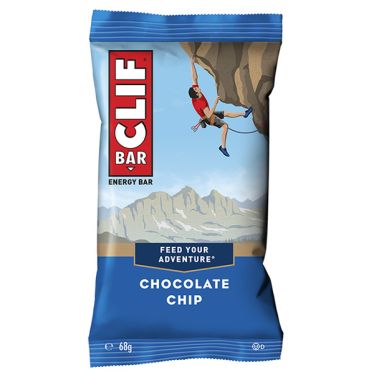






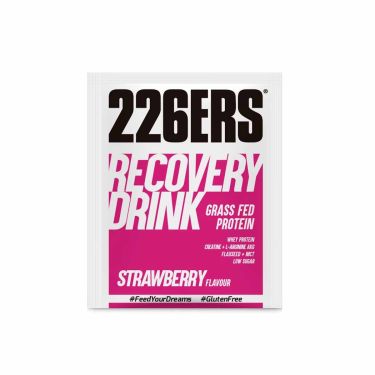

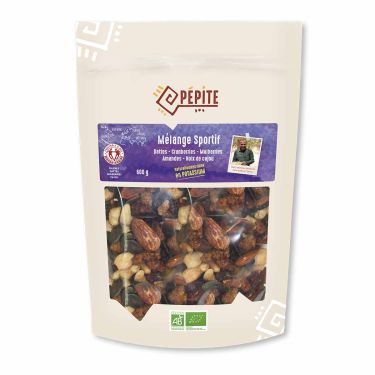

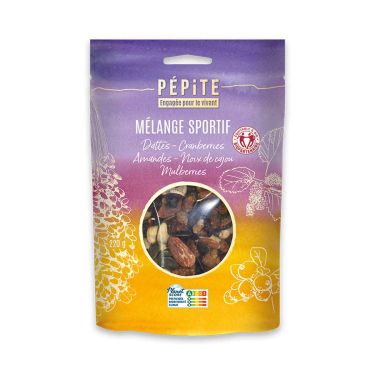





Leave a comment